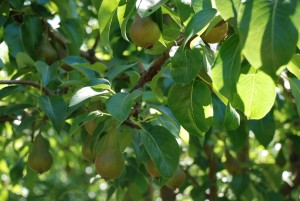For many reasons growing pears in the Southeastern U.S. is very challenging. First, European (Pyrus communis) and Asian (P. pyrifera) pears are susceptible to fireblight (Erwinia amylovora). This bacterial disease is very difficult to manage. Two of the leading European pear varieties, ‘Bartlett’ and ‘Bosc’, are highly susceptible to fireblight. Varieties found to be fire blight resistant include: ‘Warren’, ‘Aires’, and ‘Moonglow’. ‘Shinto’, an Asian pear variety with russet brown fruits, exhibits above average fireblight resistance.
European pear varieties do not ripen on the tree. Fruits are harvested on the scheduled date for the variety and ripened indoors. Unripened pears should be stored in a closed plastic or paper bag (sack) for 7-10 days at room temperature (60-70 °F). Fruits may then be refrigerated to slow down their ripening. As with apples, Asian pears ripen on the tree, and are ready to eat when harvested. Asian pears are picked from late August to early October, depending on the variety grown.
European pear varieties will not pollinate Asian pears. Asian pears tend to bloom several days later than European varieties. Both European and Asian pears require cross-pollination from two or more different varieties which bloom near the same time.
Both European and Asian pears are notorious for “biennial bearing”. A tree may overproduce one year, and yield a small crop the next (the “off” year). Biennial bearing in the “on” year often results in limb breakage and smaller fruits. To prevent or break the biennial bearing cycle, remove excess fruit by hand within 30 days after full bloom in the “on” year. As a rule, 30-40 leaves support one pear fruit.
Finally, pruning pear trees can be a chore. Pears have a strong vertical branching form. Trees often grow tall and narrow, not easily within reach without a tall step ladder. Current pear dwarfing rootstocks have not been reliable, although better types may be available a few years away.


 Posted in
Posted in 
